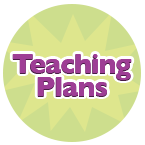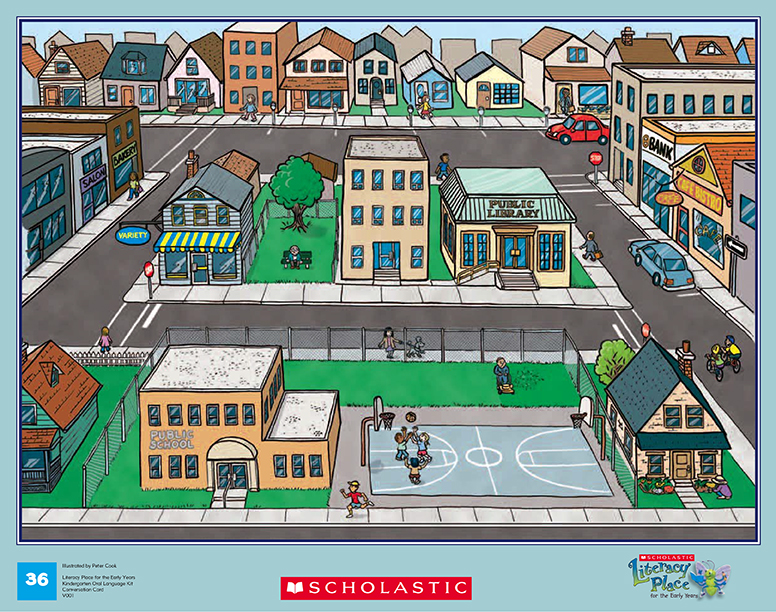Oral Language Teaching Strategy:
Encourage Partner Talk Encourage students to talk through their ideas with a partner before sharing their ideas with the group.
Time: one 30-minute lesson or two 15-minute lessons
Materials:
– Map Card #36
– Boy and Girl on Bikes BLM
Grouping: whole class or small group
Assessment:
Kindergarten Oral Language Assessment Scale
FOCUSING ON THE PICTURE
[Analyzing/Inferring]- Show the students the neighbourhood map. Ask them to look at it carefully and think about what is happening.
- After students have had adequate time to look at the map, invite them to share their ideas with a partner.
- Provide time for partner discussion and then invite a few partners to share their thinking.
What kind of picture is this? That’s right, it’s a map. What kinds of things are in this map? If you were in this map, where would you be? I think I would be in the school teaching or maybe the library because you know I love books!
It’s helpful to talk about your ideas with partners because they might have ideas you haven’t thought of.
- Offer prompts to stimulate discussion:
- What do you think this map shows? Why do you think so?
- Who are all the people in this map?
- Do you see any of these people in your neighbourhood? Explain.
- What are some of the ways people are moving in this map? Let’s make a list.
GOING DEEPER
[Inferring/evaluating]-
Who likes to ride a bike? That’s great. I love to ride a bike. It is great exercise. Let’s follow the girl as she explores the neighbourhood on her bike.
Introduce the girl on the bike (see the Boy and Girl on Bikes BLM) to the students. Invite students to give the girl a name.
-
Use the character to trace a journey on the map while telling a story:
This neighbourhood looks like a nice place to bike around. Where
do you think we should start? Tae Ho thinks we should start where
the red car is. That is a great idea. Let’s pretend that the house
that the red car is in front of is the girl’s house and start there.
Where do you think we should go first? That’s a great idea. Let’s
go to the bakery for breakfast but where is the bakery?
- Have a student help you find the bakery. Continue having students help you locate places on the map (see the Boy and Girl on Bikes BLM).
Okay, we found the bakery but how will we get there? Let’s trace
the path and see what direction we need to go. We need to go
straight and then turn left at the crosswalk. Let’s go! We’ve had
breakfast so now the little girl needs to return her library books.
How will we get to the public library? Let’s find it together on our
map. (As you trace the path to the library, verbalize the directions
to get to the library.) We found out that we need to go straight
until we see the variety store and then make a left. The library is
at the end of the street on the left side. Oh, oh, it is almost 9 o’clock.
Where do you think the little girl has to go now? She can see the
school from the library but there is a big fence. How should she
get to school? Let’s trace the path with our finger. Now we know
that she must turn right at the street by the public library and then
turn right again at the next street where the lady is gardening in
her front yard, and then the school will be on her right side. Phew,
we are lucky she is not late.
- Invite students to tell another story by taking turns to move the boy character around the map (see the Boy and Girl on Bikes BLM).
You may conclude the lesson at this point and do the second part on the next day, or you may decide to continue and do Connecting and Predicting as part of the first lesson.
CONNECTING
Teaching Tip: If you decide to do Connecting and Predicting on the second day, begin your lesson by reviewing the picture with the students.
[Making connections]-
Ask students to draw on their personal experiences to make connections
to the map. Prompts might include:- If we walked out the front door of the school on the map,
what would we see? - What would you see in your neighbourhood?
- What is your favourite place to visit in your neighbourhood?
- Who do you see in your neighbourhood?
- What are the names of some of the places in your neighbourhood?
- If we walked out the front door of the school on the map,
PREDICTING
[Predicting]-
Are there times of the day when your neighbourhood is busier? Why do you think it is busier at that time? What do you think will happen next? Why do you think this?
Ask students to think about the things that happen every day in their neighbourhood and what might happen after the scene shown on this map.
LESSON EXTENSIONS
-
Take students on a neighbourhood walk. Have them focus on the places and things they see in their neighbourhood. When you get back to the school, have students create a class mural of their neighbourhood.
-
Provide students with their own school map or create one as a class. Have a map with a rectangle in the middle representing the school. Work with students to label the streets around the school and the landmarks they see every day.
-
Have students role play with a partner or small group things they like to do or places they like to go in their neighbourhood. Let each group perform their skit.
-
Work with students during a shared writing lesson to create a big book about what they see in their neighbourhood. (You might model the book after the pattern used in Brown Bear, Brown Bear, What Do You See? by Bill Martin Jr. and Eric Carle.)
FOLLOW-UP IN CENTRES
-
Provide students with blocks and figures they can use to create a map at the sand table.
-
Have students use blocks to create their own community. They can paint a picture of what they have created after they have built it.
- Prominently display the map and encourage students to use the character cut outs to direct each other to different places in the neighbourhood.

